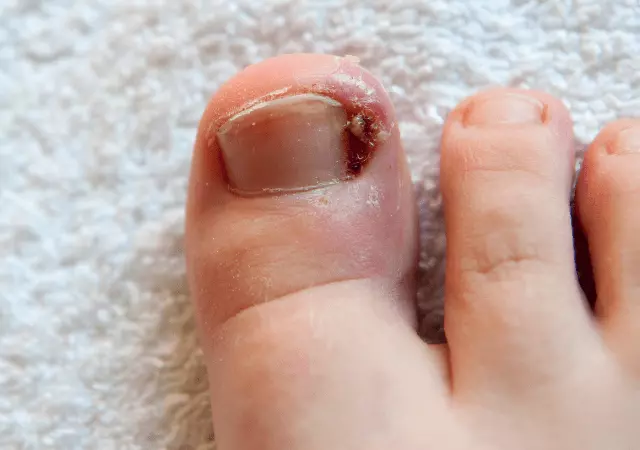Looking for essential oils for ingrown toenail? You have found the right page.
In this article, you’ll read about some of the best essential oils for ingrown toenail that are evidence-based and considered safe to use.
Read: Essential Oils for Cracked Heels
Contents
The Best Essential Oils for Ingrown Toenail

Here are some of the best essential oils:
1. Tea Tree Essential Oil
Tea tree oil is a popular essential oil that can be used to treat an ingrown toenail. It has antiseptic and anti-inflammatory properties, which are very essential in treating this condition.
When used properly, it can reduce pain and inflammation and also help prevent infections and promote healing.
According to a 2013 study, this essential oil is very effective in promoting the fast healing of wounds caused by bacteria.
2. Lavender Essential Oil
Lavender oil has anti-inflammatory and analgesic properties, which are very beneficial in treating ingrown toenail.
The oil is equally used for its calming and soothing effects, which can help reduce stress and anxiety during the recovery period.
In a 2019 study, researchers found that the use of lavender oil is very effective in wound healing for the first three days (p=0.035). The study noted the enhanced proteins activity, increased expression of collagen, and faster rate of wound healing.
The researchers noted the potential therapeutic benefits of this essential oil in wound healing. However, there is a need for intensive human research for the efficacy determination of this essential oil in promoting faster wound healing.
3. Eucalyptus Essential Oil
Eucalyptus essential oil has many beneficial properties that can potentially help with ingrown toenails.
The oil has strong antimicrobial properties that can help fight against bacteria and other microorganisms that may localize in the infection site.
Additionally, the anti-inflammatory properties of eucalyptus oil can help reduce the swelling and inflammation that can occur around the ingrown toenail causing pain and irritation.
According to studies, eucalyptus oil has wound-healing properties that can help speed up the wound-healing process. The researchers also noted that a synergy of eucalyptus oil and olive essential oil promotes superfast wound healing.
4. Peppermint Essential Oil
Peppermint oil is a natural analgesic and anti-inflammatory agent, which means it, can have serious positive impacts when used to treat an ingrown toenail.
It also has a cooling effect, which can help soothe the skin and reduce discomfort.
In case of an ingrown toenail, the immune system responds by sending cytokines and inflammatory cells which results in pain, swelling, and redness. Luckily, peppermint has anti-inflammatory properties that help to manage the situation.
According to this study published in 2019, oral administration of peppermint oil prevents xylene-induced gut inflammation in mice and at the same time reduces the production of inflammatory mediators in human monocytes.
5. Frankincense Essential Oil
Frankincense oil has been used for thousands of years for its healing, antiseptic, anti-inflammatory, and anti-bacterial properties. It contains numerous compounds, including alpha-pinene, limonene, and beta-caryophyllene, which are therapeutic.
Inflammation is a natural part of the body’s healing process, but when it becomes chronic or excessive; it can delay wound healing and cause pain, redness, and swelling of the ingrown toenail.
Luckily, the oil contains compounds that have anti-inflammatory properties. These compounds help in reducing swelling, redness, and pain in patients with an ingrown toenail.
According to studies, frankincense oil can improve blood circulation in the affected area which helps to speed up the healing process.
Improved blood flow to the affected area brings oxygen and nutrients to the cells involved in healing, allowing them to work more efficiently.
Precautions!
- Dilute essential oils with a carrier oil before use
- Avoid ingesting as they can cause poisoning, nausea, and vomiting
- Use with caution during pregnancy and for children
Side Effects
- Skin irritation
- Nausea
- Vomiting
- Eye redness
How to Use Essential Oils for Ingrown Toenail?
Following are some of the best ways you can use these essential oils:
1. Dilute and Apply Topically
Dilute a few drops of any essential oil of your choice with a carrier oil (coconut or almond oil). Now apply it directly to the site and leave it there for as long as you can.
Repeat it daily for at least a month to start seeing results.
2. Foot Soak
Take your favorite essential oil, add a few drops to a warm footbath, and soak your feet for 15-20 minutes. Repeat this twice a day for several weeks.
3. Diffuse
You can also add a few drops of your favorite essential oil to a diffuser to create a relaxing and calming atmosphere, which may help reduce stress and tension.
The Bottom Line!
The above-mentioned essential oils for ingrown toenail are some of the best and safest essential oils available.
Although for most people they are safe to use, you may experience discomfort with the use. In such a case, stop the use and consult with your physician.
The content present on this page has not been evaluated by any medical authorities e.g FDA. All the information present is solely for informational purposes and is not a substitute for the medical advice provided by your physician. We do not aim to diagnose, treat, or cure any disease or illness.

I am a medical student (MD) and a professional blogger. My aim is to help and educate people about essential oils and how they can be beneficial in improving overall health if used in a proper way.
